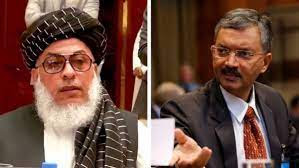Takshashila University
The university of ancient Takshashila was an ancient university located in the city of Takshashila (Sanskrit: तक्षशिला) (modern day Pakistan), on the eastern bank of the Indus river in Punjab, Pakistan. It became the capital of the Achaemenid territories in northwestern South Asia following the Achaemenid conquest of the Indus Valley around 515 BCE. Taxila was at the crossroad of the main trade roads of Asia, was probably populated by Persians, Greeks, Scythians and many ethnicities coming from the various parts of the Achaemenid Empire.
Professors
Important professors that are said to have taught at university of Taxila include;
- Pāṇini, the great 5th century BCE Indian grammarian, is said to have been born in Shalatula near Attock, not far from Taxila. This region was then part of the Gandhara satrapy of the Achaemenid Empire, but the ethnicity in his name or the way of his life shows that he was of Indian origin. He is likely to have been teaching at Taxila university.
- Chanakya, the influential Prime Minister of the founder of the Mauryan Empire, Chandragupta Maurya, is also said to have been teaching at Taxila.
- Kumāralāta, according to the 3rd century Chinese Buddhist monk and traveller Yuan Chwang, Kumāralāta, the founder of Sautrāntika school was also an excellent teacher at Taxila university and attracted pupil from as far as China.
Students

Students with their oblong palettes used for writing, in the Greco-Buddhist art of Gandhara. The young Buddha accompanying them to go to school is also part of the complete scene. 2nd-3rd century CE, Victoria and Albert Museum.

Bhir Mound, excavation of ancient buildings.
According to Stephen Batchelor, the Buddha may have been influenced by the experiences and knowledge acquired by some of his closest followers in the foreign capital of Taxila. Several contemporaries, and close followers, of the Buddha are said to have studied in Taxila, namely:
- King Pasenadi of Kosala, a close friend of the Buddha,
- Bandhula, the commander of Pasedani's army
- Aṅgulimāla, a close follower of the Buddha. A Buddhist story about Aṅgulimāla (also called Ahiṃsaka, and later a close follower of Buddha), relates how his parents sent him to Taxila to study under a well-known teacher. There he excels in his studies and becomes the teacher's favorite student, enjoying special privileges in his teacher's house. However, the other students grow jealous of Ahiṃsaka's speedy progress and seek to turn his master against him. To that end, they make it seem as though Ahiṃsaka has seduced the master's wife.
- Jivaka, court doctor at Rajagriha and personal doctor of the Buddha.
- Charaka, the Indian "father of medicine" and one of the leading authorities in Ayurveda, is also said to have studied at Taxila, and practiced there.
- Chandragupta Maurya, Buddhist literature states that Chandragupta Maurya, the future founder of the Mauryan Empire, though born near Patna (Bihar) in Magadha, was taken by Chanakya for his training and education to Taxila, and had him educated there in "all the sciences and arts" of the period, including military sciences. There he studied for eight years. The Greek and Hindu texts also state that Kautilya (Chanakya) was a native of the northwest Indian subcontinent, and Chandragupta was his resident student for eight years. These accounts match Plutarch's assertion that Alexander the Great met with the young Chandragupta while campaigning in the Punjab.








Comments
Post a Comment